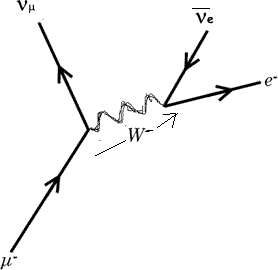Leptons
 Lepton is Greek
for 'small'.
Lepton is Greek
for 'small'.
Leptons do NOT experience the strong nuclear force, rather
any nuclear interactions they are involved in are via the weak nuclear force.
The leptons (we have
to know about!) are:
 the electron
(e- or
the electron
(e- or  )
)
 the positron
(e+ or
the positron
(e+ or  )
)
 the muon
(
the muon
( -) and
-) and
 the antimuon
(
the antimuon
( +) - basically a 'heavy electron'
(about 200 times the mass)
+) - basically a 'heavy electron'
(about 200 times the mass)
 the neutrino
(
the neutrino
( ) and
) and
 antineutrino (
antineutrino ( )
( both with virtually no mass and zero charge)
)
( both with virtually no mass and zero charge)
Quantum Numbers: Lepton Number, Baryon Number and Strangeness
Electron leptons have
a lepton number Le of +1 and their antileptons a lepton
number -1.
Muon leptons have
a lepton number L of +1
and their antileptons a lepton number -1.
of +1
and their antileptons a lepton number -1.
Leptons have zero
baryon number and zero strangeness.
Electron stability
The electron is stable because there is no lighter particle into which it can decay.
Muon production
Muons are produced
by the weak decay (via a w-boson) of pions into a muon and a muon antineutrino.
On earth, muons are
created when a charged pion decays in the upper atmosphere. The pions
are created by cosmic radiation and have a very short decay time--a few
nanoseconds. The muons created when the pion decays are also short-lived:
their decay time is 2.2 microseconds. However, muons in the atmosphere
are moving at very high velocities, so that the time dilation effect of
special relativity make them easily detectable at the earth's surface.
Muon stability
 The muon differs from
the electron in that it is unstable, decaying with an average lifetime
of 2.2 × 10-6 seconds (2.2 microseconds) decaying into an
electron, an electron-antineutrino, and a muon-neutrino.
The muon differs from
the electron in that it is unstable, decaying with an average lifetime
of 2.2 × 10-6 seconds (2.2 microseconds) decaying into an
electron, an electron-antineutrino, and a muon-neutrino.

Muonic atoms
Muons can be substituted
for electrons in orbit around the nucleus of an atom.
The resulting atom
is long-lived enough to exhibit behaviour that further supports the close
resemblance between the muon and the electron.
Recent studies of muons
have included the production of “muonic atoms” (ordinary atoms
to which an orbiting muon is added) and muonium, which consists of an
electron in orbit around a positive muon. Muonic atoms are much smaller
than typical atoms because, in order to conserve angular momentum, the
more massive muon must be closer to the atomic nucleus than its less massive
electron counterpart.



 Lepton is Greek
for 'small'.
Lepton is Greek
for 'small'. 



